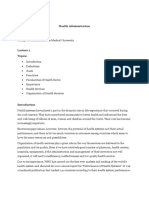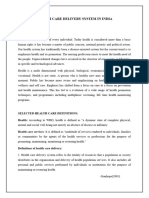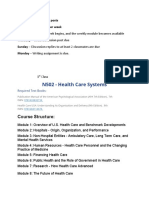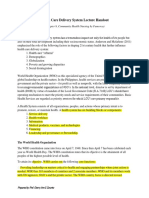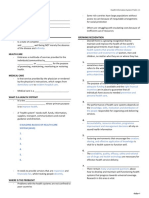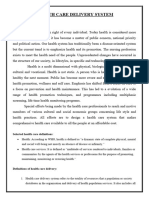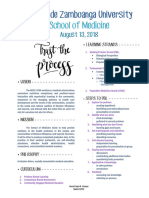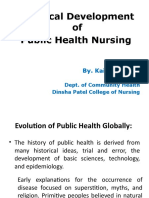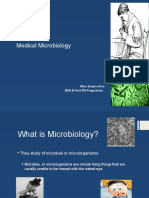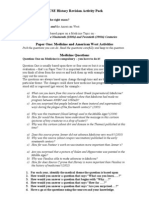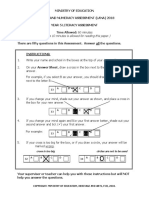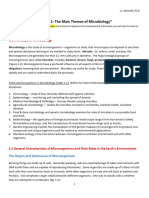Name: Sumajel ,Yhecia R.
Score:______________
Section: 2CMTM-1 Schedule: THUSAT 1:00PM-5:30PM Date: July 13, 2024
DIRECTION: On a separate sheet of paper, copy and paste the questions in red font color/ink. Answer the questions direct
to the point using black ink. Take note that not all questions require referencing but an answer that comes from your own
stand and perception. Use APA format of referencing and make a brief bibliography for the detail of the resources.
1. As a review in Health Information Systems subject, enumerate and briefly discuss the building blocks of healthcare
systems.
Healthcare systems are intricate and multidimensional, made up of several components that cooperate to
guarantee efficient healthcare provision. The main components are as follows:
Health services delivery, which includes basic care (management of common ailments and preventative care),
secondary care (specialist services offered upon referral), and tertiary care (complicated and sophisticated
treatments).
Support workers (administrative and operational people) and healthcare professionals (physicians, nurses,
pharmacists, and allied health professionals) comprise human resources.
Information systems for health management are essential for data gathering, administration, and health
informatics—the use of IT to enhance patient outcomes and optimize procedures.
Pharmaceuticals (medications and vaccines), medical devices (diagnostic and therapeutic tools), and health
technology (telemedicine and electronic health records) are examples of medical products, vaccines, and
technologies.
2. Which among of those building blocks do you think is very vital? Justify your answers?
The provision of medical treatment has a direct impact on patient outcomes, making health services delivery the
most crucial element of healthcare systems. Good health services encourage the early detection of illnesses, the
management of chronic conditions, and the use of prevention measures, all of which have a significant influence
on the general health of the population. It combines a number of elements, such as health information
technologies, medical supplies, and the medical staff, to deliver exceptional patient experiences and efficient use
of resources. The potential for bettering health outcomes cannot be completely realized by advancements in other
domains, like funding and technology, unless health services are provided more effectively.
3. As a future medical technologist, how can you participate and contribute to the healthcare system?
� I will fulfill my duties and responsibilities in clinical laboratories as a future medical technician while abiding by the
medical technology code of ethics. I am not unintelligent; I can avoid malpractices. I uphold justice and morality. I
would be disciplined appropriately if I violated the code of ethics.
4. What is the role of WHO, CDC, DOH and LGU in providing a quality health care system?
WHO provides evidence-based guidelines and regulations to help countries develop and successfully implement
health care systems. It focuses on illness prevention, health promotion, and healthcare delivery while offering
technical assistance and capacity building to improve national health systems. In order to help countries respond
to emergencies and enhance health outcomes, WHO also tracks and evaluates health trends. It also promotes
teamwork and partnerships in order to address global health concerns and give everyone equitable access to high-
quality healthcare.
When it comes to all things related to disease prevention and control, the CDC will always be the technical
authority. Its duties encompass developing policies and standards, providing technical support and capacity
building, interacting with local and sectoral organizations, and conducting surveillance. Additionally, under the
CDC, Regional Centers for Disease Prevention and Control (RCDCs) will be formed. Public health disaster
preparation can be enhanced at different local government levels by use of the RCDCs.
5. Differentiate rights and obligations.
Despite their apparent similarity, these two ideas are actually completely different from one another. Legal, social,
and ethical conceptions of freedom or entitlement owed by individuals or groups are known as rights. These are
the fundamental guidelines that let individuals live their life independently of other people. Rights are not always
good. Positive rights are those that call for action to give people particular advantages or services. Conversely,
negative rights require inactivity, meaning that others cannot impede on a person’s capacity to exercise their
rights. The duty or responsibility that a person or organization has to carry out a specific task or keep a promise is
known as an obligation. It is required by law or morality to carry out certain tasks or to meet
6. Based on the definition, what do you think are the rights and obligations of medical technologist?
Medical technicians are entitled to a respectful workplace, professional growth opportunities, equitable pay, and
a safe working environment. They have an obligation to follow guidelines, guarantee the caliber of their job, protect
patient privacy, participate in ongoing education, and support moral behavior.
7. What is the distinct and unique nature of a healthcare system?
Healthcare system is an organization of healthcare delivery system that caters to the health needs of the target
population. WHO is empowered to coordinate and direct people to meet ad promote quality healthcare system
globally. Primary goal of UN is to promote quality health and state of wellness to everyone. With this goal, it opens
a greater opportunity of good health in line with: Showing the interrelationship of components; Providing an
additional institutional support or introducing the aspects of the healthcare system as a whole; Vehicles for health
improvement and equity in response to legitimate expression of views or opinions, respect for dignity, and fair
financing to needy people; Defining its goals in terms of providing health care services and defining its enabling
� functions, more particularly stewardship, finances, and generating resources for the most complex individuals, the
workforce.
8. What is Health? How do you tell if a person is healthy or not?
Health is a state of complete physical, mental, and social well-being, not merely the absence of disease or infirmity.
• Physical Health: Evaluate criteria such as fitness levels, vital indicators (blood pressure, heart rate, etc.),
the absence of chronic illnesses, and the normal operation of body systems.
• Mental Health: Assess your emotional well-being, cognitive performance, stress levels, and capacity to
deal with daily obstacles.
• Social Health: Assess social contacts, relationships, and capacity to participate in community and social
activities.
9. What is Disease? Illness? and Sickness? How can we determine if a certain individual has such?
Disease is a state or condition in which adjustment (physiological or psychological) is present. it occurs in the
present of host, agents and environment. Disease is synonymous with illness and sickness, sometimes it can be
referred to as disorder. Such can be brought about by the environment, agents, or the host itself. It can also be
defined as a “pathological process” must often associated with a physical or undetermined origin. Disease occurs
whenever there is a deviation from the normal biological form. Illness is a feeling unhealthy experience by the
person himself/herself. Sickness is an external and public mode of unhealthy. It can be considered as a social role,
status, or negotiated position in the world. Disease is the malfunctioning or dysfunction of organ system or tissues,
which causes physical or mental disturbances. Illness or sickness is a more subjective concept related to personal
experience of a disease and varies from one person to another.
10. Discuss the Epidemiological Triad by giving an example/s to a certain disease.
Epidemiological Triad is a traditional model of infectious diseases that involves the agent, host and environment.
This model holds that when host and agent combine, they cause disease that occurs in the body of the host but it
requires a vector coming from the environment that transmits and transfers the disease from one host to another.
For example, Malaria is a communicable disease that infects humans. It has two host, female Anopheles the
mosquito which is the definite host and humans are its intermediate host. Although, human is the host in E.Triad,
then our agent is the mosquito which is a biological agent, and lastly, the environment is also biologically
dependent since mosquitoes lay their offsprings in water.
� 11. What is the difference between Disease and Disorders?
A disease is a medical condition that interferes with an organ's, tissue's, or system's ability to function normally. Infections,
genetic mutations, environmental factors, or a combination of the three are typically the causes. Acute or chronic diseases
can develop gradually over time or suddenly occur. Diabetes, cancer, heart disease, and Parkinson's disease are among the
illnesses. The kind and degree of the ailment determine the symptoms of the disease. Any functional irregularity or
disruption that compromises a person's physical or mental health is referred to be a disorder. It may make it more difficult
for someone to function in daily life, interact with others, or preserve relationships. Unlike illnesses, disorders may not
always have an obvious underlying cause and might be impacted by environmental factors as well as heredity. Disorders
can be classified into several sorts based on their nature and the afflicted bodily system. Common disorders include anxiety
disorders, mood disorders, personality disorders, sleep problems, and neurodevelopmental disorders like autism.
Disorders are frequently caused by complicated interactions between genetic, environmental, and psychological variables.
Certain disorders, such as schizophrenia and bipolar illness, may be influenced by hereditary factors. However,
environmental variables such as stress and trauma can also contribute to the development of these disorders. Personality
features and coping techniques might also contribute to the development of a condition. Disorder symptoms vary
depending on the disease and might have an impact on a person's mental or physical health.
12. Discuss the chain of infections.
The six interconnected steps of the “chain of infection” are the infectious agent, reservoir, portal of entrance,
mechanism of transmission, and vulnerable host. The term “chain of infection” describes the process by which
infectious diseases spread from one host to another. An environment, an animal, or a person can serve as a
reservoir for the infectious agent, such as a virus or bacteria. Via an exit portal, the agent leaves the reservoir (e.g.,
respiratory tract, blood). Direct touch, droplets, or vectors like mosquitoes are the ways in which transmission
happens.
13. Discuss the Koch’s postulate.
Koch's postulates are four criteria used to determine the causal link between a pathogenic bacterium and a
disease. Robert Koch and Friedrich Loeffler devised the postulates in 1884, and Koch revised and published them
in 1890. Koch used the postulates to determine the causes of anthrax and TB, but they have now been extended
to other illnesses.
Koch’s postulates are the following:
1. The microorganism must be found in abundance in all organisms suffering from the disease, but should
not be found in healthy organisms.
2. The microorganism must be isolated from a diseased organism and grown in pure culture.
3. The cultured microorganism should cause disease when introduced into a healthy organism.
4. The microorganism must be reisolated from the inoculated, diseased experimental host and identified as
being identical to the original specific causative agent.
14. Who is Ignaz Semmelweis? What is his significant contribution in the disease prevention and control?
� Ignaz Semmelweis was a Hungarian physician who discovered the cause of puerperal (childbed) fever and
introduced antisepsis into medical practice. He was born on July 1, 1818, in Buda, Hungary, Austrian Empire [now
Budapest, Hungary] and passed away on August 13, 1865, in Vienna, Austria. It is attributed to him that the
connection between hygiene and the containment of disease outbreaks was made.
15. What are the different agents of the disease and its etiological factors?
• Biological Agents- these are also called pathogens (Gr. pathos means disease; genesis means producing).
These are those micro-organisms which when successfully infect the human body, multiply and produce
toxins in incubation period which interfere with the normal functioning of the body and cause a disease.
These include bacteria, viruses, rickettsias, fungi, protozoans, helminths etc. Out of these, protozoans are
one-celled protists, while helminths are multicellular animals.
• Chemical agents- which may be endogenous e.g., urea, uric acid, hormones, enzymes etc.; or exogenous
e.g. pollutants like gases, dust, metals, fumes; and allergens like spores, pollens etc.
• Nutritive agents- e.g., minerals, carbohydrates, proteins, fats, vitamins and water.
• Physical agents- e.g., heat (stroke), cold (frost bite), radiations, sound (impaired hearing), etc.
• Mechanical Agents-these include injuries, fractures, sprains, dislocations, etc.
16. What are the classifications of the disease based on its occurrence?
The most commonly used categories of disease are:
(1) topographic, which is based on a body system or region;
(2) anatomic, which is based on an organ or tissue;
(3) physiological, which is based on function or effect;
(4) pathological, which is based on the nature of the disease process;
(5) etiologic (causal);
(6) juristic, which is based on the speed at which death occurs;
(7) epidemiological; and (8) statistical. A single illness may fit into more than one of these categories.
17. Which among the preventions of the disease will you adopt?
� Exercise or physical activity protects against non-communicable diseases like cancer and cardiovascular disease,
but handwashing is the simplest and most straightforward method of preventing communicable diseases like
germs, viruses, and parasites.
18. What are the philosophical implications of diseases?
• Supernatural causes and karma which explains that disease is brought about by the bad things to others
or by the work of supernatural beings. Sometimes, an injury may be caused by superstitious beliefs.
• Theory of humors – bodily fluids. Humor- It is medical terms refer to it are temperament and disposition.
The theory of humors refers to four humors: choleric, melancholy, phlegmatic, and sanguine. It was
formulated because of the variations in temperament or illness as a result of the intermixing of the four
humors in different quantities. The four humors are associated with specific elements (air, water, earth
and fire), the four balance and purified humors are responsible or the normal growth, metabolism, and
nutrition of an organism. When there are our humors are balanced and working harmoniously together is
called “Eucrasia”. Four humors are imbalanced and not working together is called as “Dyscrasia”.
• Miasmatic Theory of Disease- It became popular in the Middle Ages when a killer disease called malaria
was caused by miasma. According to this theory, the cause of this disease is evidenced by the presence of
poisonous vapor in the air containing suspended particles of decaying matter.
• Germ Theory of Disease – the underlying purpose of this theory is to encourage people to clean the
environment and maintain good sanitation. Robert Koch established the germ theory of disease. Girolamo
Fracastoro, an Italian physician, suggested that invisible organisms may cause diseases. Germ theory was
supported by Galen’s miasma theory and became popular because of the convincing evidence presented
by Louis Pasteur.
• Theory of Contagion- It was supported by the germ theory and humor theory, but with this theory, it was
premised the fact that diseases were caused by microorganisms that spread the disease from one
organism to another. Diseases may occur through direct and indirect contact through inanimate objects
and done through long-distance transmission.
19. Differentiate pathogenicity and virulence.
Pathogenicity is the ability of a pathogen to produce disease, whereas virulence is the ability of a pathogen or
microbe to infect or harm a host. This is the primary distinction between pathogenicity and virulence. Furthermore,
virulence factors determine pathogenicity.
20. What are the virtues should you possess as a healthcare provider?
A competent healthcare provider is passionate and equipped with values. Among others, some healthcare
professionals exhibit unprofessional behavior.
In a hospital or clinical context, favoring current procedures above the best and most desirable ones.
Emphasizing sickness over prevention o Poorly presenting the available data.
Acting as though they are superior to or on par with all other healthcare practitioners.
�21. Discuss the cardinal virtues of healthcare providers by giving an example or a certain situation in the field of
medicine, medical laboratory science and healthcare settings.
Prudence is the application of reason based on experience. Making the correct decision is necessary for the
disposition of good deeds. Particularly in clinical settings, the health care professional exhibits a predisposition or
habitual disposition in choosing the appropriate path and making the right decision.
Justice can be carried out or carried out by respecting, obeying, and honoring God. It also means treating patients
fairly, irrespective of their financial situation. It has to do with the principle of establishing equality for both the
individual and the greater welfare.
The quality of remaining steadfast and brave in the face of adversity is known as fortitude.
Self-control and moderation are parts of temperance. It ought to have, particularly while interacting with patients
or even when deciding on pleasures and pursuing their own happiness in life. It gauges man’s lack of instinct by
limiting desires to the bounds of what is ethically right and
22. Illustrate the virtues derived from the professional commitment.
1. Fidelity to Trust - equivalent to loyalty; every healthcare provider should earn the trust of the patients for his/her
dedication to work counts a lot.
2. Intellectual Honesty - it is something that is being earned through hardship and dedication to work. An
admission of a healthcare workers that he/she does not know a procedure is not a violation of this virtue
provided that he/she admits such a lack of knowledge and experience with honesty and humility.
3. Courage – is reinforced by fortitude. A healthcare provider should have such a quality especially when
confronted by difficulties and hardships at work.
4. Benevolence – principle of bioethics is derived from the Latin phrase primum non nocere which means “first,
do no harm.” From the time of Hippocrates when he said physicians must do good to patient.
5. Compassion - every healthcare professional must assume the predicament that the patient’s rights are attuned
with his/her scientific judgment about the results of the laboratory examination.
6. Truthfulness – a patient must assess the competence and truthfulness of all healthcare workers.
23. What is prima facie duties?
1. Duties of fidelity: telling the truth, keeping actual and implicit promises, and not representing fiction as history.
� 2. Duties of reparation: righting the wrongs we have done to others.
3. Duties of gratitude: recognizing the services other have done for us.
4. Duties of justice: preventing a distribution of pleasure or happiness that is not in keeping with the merit of the
people involved
5. Duties of beneficence: helping to better the condition of other beings with respect to virtue, intelligence, or
pleasure.
6. Duties of self-improvement: bettering ourselves with respect to virtue or intelligence.
7. Duties of non-maleficence: avoiding or preventing an injury to others.
W.D. Ross Ross does not rank these duties in order of importance. The mature person intuitively knows that Prima
facie duties are true and may follow the appropriate duty given the demands of the particular situation.
24. What is meant by good virtues?
Morally admirable and desirable characteristics in people are called good virtues. These moral qualities shape conduct,
impact choices, and enhance an individual's general moral character. They are frequently linked to living a decent and
contented life and cultivating peaceful and fruitful interpersonal interactions. Honesty, integrity, courage, compassion,
humility, kindness, and patience are some of these admirable qualities.
REFERENCE
The Philippines Health System Review European Union. (n.d.).
https://iris.who.int/bitstream/handle/10665/274579/9789290226734-eng.pdf
Agency’s Mandates and Functions. (n.d.). Centralluzon.doh.gov.ph.
https://centralluzon.doh.gov.ph/index.php?option=com_content&view=article&id=3&Itemid=185
Joint Administrative Order No. 2021 - _. (2021). https://dilg.gov.ph/PDF_File/issuances/joint_circulars/dilg-
joincircular202183_de33659ec4.pdf
Rights vs Obligation: When To Use Each One In Writing. (n.d.). The Content Authority, 607-216–8113.
https://thecontentauthority.com/blog/rights-vs-obligation
Williams, G. (n.d.). The unique nature of the healthcare environment. In Oxford University Press Sample Chapter.
https://www.oup.com.au/__data/assets/file/0013/132025/9780195596144_SC.pdf
�Rai, V. (2023, November 14). What is the difference between disease and disorder?
https://www.icliniq.com/articles/diseases-and-disorders-common-medical-conditions/disease-vs-disorder
Centers for Disease Control and Prevention (CDC). (n.d.). Infection Control. Retrieved from
https://www.cdc.gov/infectioncontrol/index.html
World Health Organization (WHO). (n.d.). Infection Prevention and Control. Retrieved from
https://www.who.int/teams/integrated-health-services/infection-prevention-control
Libretexts. (2022, December 24). 10.1D: Koch’s Postulates. Biology LibreTexts.
https://bio.libretexts.org/Bookshelves/Microbiology/Microbiology_(Boundless)/10%3A_Epidemiology/10.01%3A_Pri
nciples_of_Epidemiology/10.1D%3A__Kochs_Postulates#:~:text=The%20postulates%20were%20formulated
R, J. (2017, March 15). Disease agents: 5 main types of disease agents | Human health | Biology. Biology Discussion.
https://www.biologydiscussion.com/diseases-2/disease-agents/disease-agents-5-main-types-of-disease-
agentshuman-health-biology/75628
Robbins, S. L., Robbins, J. H., Scarpelli, D. G., & Burrows, W. (1999, July 26). Human disease | Definition & Facts.
Encyclopedia Britannica. https://www.britannica.com/science/human-disease/Classifications-of-diseases
Lakna. (2019, November 28). What is the Difference Between Pathogenicity and Virulence. Pediaa.Com.
https://pediaa.com/what-is-the-difference-between-pathogenicity-and-virulence/


















